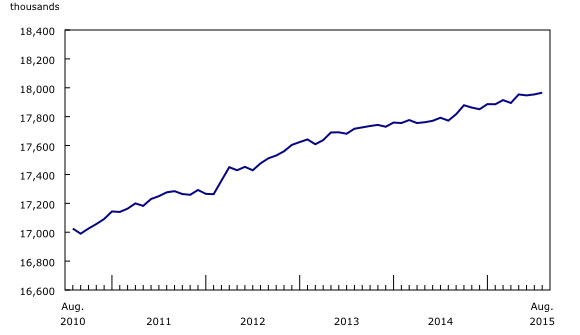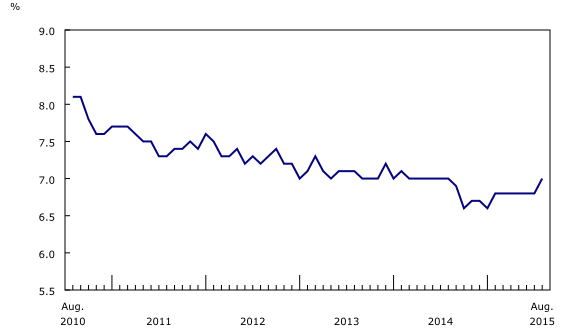Labour Force Survey, August 2015
Archived Content
Information identified as archived is provided for reference, research or recordkeeping purposes. It is not subject to the Government of Canada Web Standards and has not been altered or updated since it was archived. Please "contact us" to request a format other than those available.
Released: 2015-09-04
Employment was little changed (+12,000 or +0.1%) in August. However, the unemployment rate increased 0.2 percentage points to 7.0%, as more people searched for work. Prior to August, the unemployment rate had held steady at 6.8% for six consecutive months.
An increase of 54,000 in full-time employment in August was mostly offset by a decline of 42,000 in part-time work.
Compared with 12 months earlier, employment was up by 193,000 or 1.1%. Over the same period, full-time work increased by 318,000 (+2.2%) while part time declined by 125,000 (-3.6%). At the same time, the total number of hours worked rose 2.1%.
In August, employment increased among women aged 55 and older, while it edged down for men and women aged 25 to 54. There was little employment change among the other demographic groups.
Provincially, employment rose in Saskatchewan, Newfoundland and Labrador, Manitoba and New Brunswick. There was little change in the other provinces.
Employment increased in public administration and educational services, while it was little changed in the remaining industries.
The number of public sector employees was up in August, while self-employment edged down. At the same time, private sector employment was little changed.
Employment up for women aged 55 and older
For women aged 55 and older, employment increased by 29,000 in August, contributing the bulk of the year-over-year growth of 35,000 (+2.2%). Their unemployment rate in August was unchanged at 5.4%, as more of them participated in the labour market.
There was little change in the employment level of men aged 55 and older, and their unemployment rate was 6.7%. In the 12 months to August, there were 77,000 (+4.0%) more men employed in this age group, largely the result of growth in their population.
For men and women aged 25 to 54, employment edged down in August, pushing their unemployment rate up 0.2 percentage points to 5.8%. However, compared with 12 months earlier, employment for this group increased by 90,000 (+0.8%).
Employment among youths aged 15 to 24 was virtually unchanged and their unemployment rate was 13.1% in August. On a year-over-year basis, there was little change in both the employment level and the unemployment rate for this age group.
Provincial summary
Employment in Saskatchewan increased by 4,000 in August, partly offsetting a decline the previous month. The unemployment rate fell 0.5 percentage points to 4.7%, still the lowest among all provinces. Compared with 12 months earlier, employment in the province was little changed.
In Newfoundland and Labrador, employment rose by 3,100 in August and the unemployment rate was 11.5%. On a year-over-year basis, employment in the province was little changed.
In Manitoba, there were 2,700 more people employed in August. However, as more people participated in the labour market, the unemployment rate was little changed at 5.7%. Compared with a year earlier, employment gains in the province totalled 8,600 (+1.4%).
Following three months of declines, employment in New Brunswick increased by 2,400 in August, pushing the unemployment rate down 0.9 percentage points to 10.1%. Compared with August 2014, however, employment in the province was little changed.
Despite little change in employment for Quebec, an increase in the number of people looking for work pushed the unemployment rate up 0.3 percentage points to 8.0%. In the 12 months to August, employment in the province increased by 40,000 (+1.0%).
In Ontario, employment was also little changed in August, and the unemployment rate increased 0.4 percentage points to 6.8% as more people searched for work. Compared with 12 months earlier, employment rose by 64,000 (+0.9%). There were notable increases in full-time work (+145,000 or +2.6%), which were partially offset by part-time losses (-81,000 or -6.0%).
In Alberta, employment was little changed in August and the unemployment rate remained at 6.0%. On a year-over-year basis, employment gains totalled 41,000 (+1.8%). However, there has been no overall employment growth in the province so far in 2015, and the unemployment rate has increased 1.3 percentage points over this period.
Industry perspective
Employment in public administration increased for the third consecutive month, up 14,000 in August. These recent increases offset earlier declines, leaving employment in the industry virtually unchanged compared with 12 months earlier.
In August, employment rose by 11,000 in educational services, continuing the upward trend that began earlier in the year. Compared with August 2014, employment increased by 53,000 (+4.2%), with most of the gains in postsecondary institutions.
Public sector employment rose by 27,000 in August, contributing to a year-over-year increase of 67,000 or 1.9%. The public sector includes all employees in public administration, most employees in utilities, as well as some employees in education, health care and social assistance, transportation and warehousing, and other industries.
While the number of private sector employees was virtually unchanged in August, it was up 124,000 (+1.1%) compared with August 2014.
Self-employment edged down in August, but was virtually unchanged compared with 12 months earlier.
Student summer employment
From May to August, the Labour Force Survey collects labour market data about youths aged 15 to 24 who attended school full time in March, and who intended to return full time in the fall. The published data are not seasonally adjusted; therefore, comparisons can only be made on a year-over-year basis.
For students aged 15 to 24, the average employment rate over the summer months (May to August) was 49.1% and the unemployment rate was 16.8%, similar to the rates observed in the summer of 2014. However, compared with the summer of 2013, the employment rate was up 0.7 percentage points, and the unemployment rate was little changed as more students participated in the labour market.
In comparison, for non-students aged 15 to 24, the employment rate in the summer of 2015 was 77.3% and their unemployment rate was 10.3%.
The average number of hours worked at all jobs by students aged 15 to 24 this summer was 24.1 hours per week, compared with 23.5 hours the previous summer. Over the same period, average hours worked by non-students in this age group edged down from 34.1 to 33.9.
For students aged 20 to 24, the rate of employment averaged 66.0% in the summer of 2015, similar to the previous two summers. On the other hand, the unemployment rate for this group of students was 10.1% in the summer of 2015, edging down from 10.6% last summer and 11.3% in the summer of 2013.
By comparison, for non-students aged 20 to 24, the employment rate was 79.3%, up 0.5 percentage points from last summer, but little changed from two summers ago. Over the same period, the unemployment rate for this group was little changed at 9.6%.
Note to readers
The Labour Force Survey (LFS) estimates for August are for the week of August 9 to 15.
The LFS estimates are based on a sample and are therefore subject to sampling variability. As a result, monthly estimates will show more variability than trends observed over longer time periods. For more information, see "Interpreting Monthly Changes in Employment from the Labour Force Survey." Estimates for smaller geographic areas or industries also have more variability. For an explanation of sampling variability of estimates and how to use standard errors to assess this variability, consult the "Data quality" section of the publication Labour Force Information (71-001-X).
This analysis focuses on differences between estimates that are statistically significant at the 68% confidence level.
The employment rate is the number of employed persons as a percentage of the population 15 years of age and over. The rate for a particular group (for example, youths aged 15 to 24) is the number employed in that group as a percentage of the population for that group.
The unemployment rate is the number unemployed as a percentage of the labour force (employed and unemployed).
The participation rate is the number of employed and unemployed as a percentage of the population.
For more detailed information, see the Guide to the Labour Force Survey (71-543-G).
Seasonal adjustment
Unless otherwise stated, this release presents seasonally adjusted estimates, which facilitates comparisons by removing the effects of seasonal variations. For more information on seasonal adjustment, see "Seasonally adjusted data – Frequently asked questions."
With this release, seasonally adjusted three-month moving average estimates for Nunavut have been added to CANSIM table 282-0100.
Sample redesign
Every 10 years, the LFS undergoes a sample redesign to reflect changes in population and labour market characteristics, as well as new definitions of geographical boundaries. The redesigned sample was introduced starting in January 2015 and was fully implemented in June 2015.
Next release
The next release of the LFS will be on October 9.
Products
A more detailed summary, Labour Force Information (71-001-X), is now available for the week ending August 15. From the Browse by key resource module of our website under Publications, choose All subjects then Labour.
Summary tables are now available online. From the Browse by subject module of our website, choose Labour.
Contact information
For more information, contact us (toll-free 1-800-263-1136; 514-283-8300; infostats@statcan.gc.ca).
To enquire about the concepts, methods or data quality of this release, contact Andrew Fields (613-951-3551; andrew.fields@statcan.gc.ca) or Lahouaria Yssaad (613-951-0627; lahouaria.yssaad@statcan.gc.ca), Labour Statistics Division.
- Date modified:




